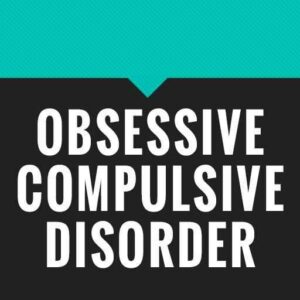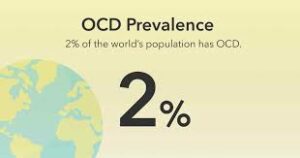Did you know that OCD is one of the most common mental disorders in the world? It is estimated that 1 in 40 adults suffers from OCD. That’s a lot of people! If you are one of those people, or if you know someone who is struggling with OCD, this blog post is for you. We will discuss what OCD is, the symptoms, and how to get help.
Contents
Defining OCD

Obsessive-compulsive disorder (OCD) is an anxiety disorder in which people have unwanted and repeated thoughts, feelings, images, and sensations (obsessions) that drive them to do something over and over (compulsions). Often the person carries out the behaviors to reduce the anxiety. But this only provides temporary relief. Not doing obsessive rituals can also cause great anxiety. A person with OCD can usually recognize that their obsessions are irrational, but they feel powerless to stop them.
The Prevalence of OCD

OCD affects about two percent of American adults and one percent of children and adolescents. It occurs equally in men and women and usually starts during childhood, adolescence, or early adulthood. OCD is often a long-lasting disorder that can interfere with every aspect of a person’s life.
In children, OCD often looks different than it does in adults. For example, a child with OCD might have persistent fears that something bad will happen to her parents if she doesn’t perform certain rituals or behaviors. A child with OCD might also be excessively concerned with symmetry and orderliness or develop repetitive motor tics (e.g., blinking, head-shaking). Overall the prevalence of OCD in children is 1 to 3%.
The prevalence of OCD in children is about two percent. That means that for every one hundred children, two of them will have OCD. Boys are slightly more likely than girls to have OCD, with a ratio of about boys to every one girl.
In adolescents and adults, the most common OCD symptoms include excessive hand-washing and cleaning; repeated checking of things (e.g., doors, stoves, locks) or hoarding objects; persistent fears of contamination or contracting an illness; and repetitive counting or ordering behaviors.
According to research, the prevalence of OCD is higher in developed countries, with a lifetime prevalence of approximately two to three percent. The disorder is equally common among males and females, although it tends to onset earlier in males (the average age of onset is 19 for males and 24 for females).
There are many possible explanations for the higher prevalence of OCD in developed countries. One possibility is that people in developed countries are simply more likely to seek out treatment for their OCD. Another possibility is that the higher prevalence of OCD in developed countries is due to increased stress and anxiety levels in these societies.
Overall, the prevalence of OCD in adults is about 2% percent. That means that for every one hundred adults, two of them will have OCD.
How To Prevent?

There are many ways that you can help prevent the development of OCD in yourself or your loved ones. Some things that may help include:
Educating yourself
The more you know about OCD, the better equipped you will be to recognize the early signs and symptoms. For instance, understanding that obsessive thoughts are common and do not necessarily mean you have OCD can help you to better manage your thoughts or those of a loved one.
Recognize the early signs
Obsessive-compulsive disorder (OCD) is a mental health condition that affects people of all ages and walks of life. The first step to getting the help you need is recognizing the early signs of OCD. While everyone experiences anxiety and worry from time to time, people with OCD experience these feelings more intensely and frequently. This can lead to a cycle of obsessions (intrusive thoughts, images, or urges) and compulsions ( repetitive behaviors or mental rituals) that interfere with daily life.
Create a support system
It is important to create a supportive network to help you cope with OCD. This could include friends, family, a therapist, or a support group. It is important to have people you can rely on to help you through tough times. They can provide emotional support and practical assistance when needed.
Help your loved ones
If someone in your life is showing signs of OCD, help them learn about the disorder so they can seek professional help if necessary. For example, you can start by explaining what OCD is and how it affects people, it will help your loved ones to overcome OCD.
Practice healthy coping mechanisms
If you’re already dealing with OCD, it’s important to find healthy ways to cope with your symptoms. This can help prevent the disorder from taking over your life. For instance, some people with OCD find relief through exposure and response prevention therapy, which involves gradually exposing themselves to their fears and learning to control their reactions to them.
Practice self-care
One of the best things you can do for yourself if you think you may have OCD is to practice self-care. This means taking care of yourself physically, mentally, and emotionally.
- Practicing stress-relieving techniques such as yoga, meditation, or deep breathing
- Getting regular exercise and maintaining a healthy lifestyle
- Eating a balanced diet and getting enough sleep
- Avoiding alcohol and recreational drugs
Stay Positive
The prevalence of OCD is rising, but that doesn’t mean you should give up hope. Early diagnosis and treatment are key to managing the symptoms of OCD. And be proactive about your mental health in general. You can’t put a price on peace of mind. Stay positive and keep fighting the good fight. Stay strong and stay positive. You can beat OCD!
Talk to a mental health professional
If you think you might have OCD. There are many different types of OCD, and it is important to get the right diagnosis so that you can get the most effective treatment. If you have OCD, there are many resources available to help you manage your condition and live a full, productive life. Don’t let OCD control your life—get the help you need to take back control.
The first step to getting the help you need is to talk to a mental health professional. They can help you understand your symptoms and develop a treatment plan that is right for you. If you don’t have access to a mental health professional, there are many resources available online or through support groups.
There is no one-size-fits-all approach to treating OCD, but many people find that a combination of medication and therapy is the most effective. Medication can help reduce the intensity of your symptoms, while therapy includes CBT or Exposure and response prevention (ERP), which can help you learn to manage your OCD.
However, it is often underdiagnosed and many people suffer in silence. OCD can have a very negative impact on an individual’s quality of life, so it’s important to be aware of the signs and symptoms.
Conclusion
It may be concluded that the prevalence of OCD is quite high and that it is therefore important to be aware of the condition. Early diagnosis and treatment are essential to prevent the condition from becoming more severe. If you or someone you know may be suffering from OCD, don’t hesitate to reach out for help.
For further information and suggestions, please contact Therapy Mantra. We have a team of expert therapists that can help you overcome this problem. Get in touch with us right away to learn more about our services. You may also make an online therapy session or download our free Android or iOS app.


